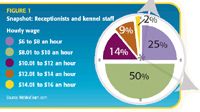Who are you?
Here's a quick snapshot of what we've learned about your career, pay, responsibilities, and feelings about veterinary practice.
Before we developed this new magazine, we asked a lot of questions. After all, we wanted to make sure we knew as much as possible about what your day is like, what challenges you face, and what issues you'd like help addressing in your practice. Here's a quick look at what we learned about your responsibilities, job satisfaction, pay, and more.

Figure 1 Snapshot: Receptionists and kennel staff Hourly wage
Your role
Receptionist, technician, veterinary assistant, practice manager—chances are, you've held one of these positions during your years in practice. But these labels don't define you—or the job you do. In fact, the 2005 AVHC Veterinary Team Study shows that many of you shift between duties that could fall under several titles; when asked to indicate all of the job titles that best describe your responsibilities, 33 percent of respondents marked manager, 20 percent receptionist, 39 percent registered veterinary technician, 28 percent veterinary assistant, and 14 percent "other." Way to go, multitaskers!

What is your biggest job frustration?
Your job satisfaction
According to the 2005 AVHC Veterinary Team Study, about 70 percent of you feel satisfied or very satisfied with your job. About 21 percent feel neutral; a bit less than 9 percent say they're somewhat or not at all satisfied with their positions. When asked how empowered they feel, respondents are less positive. Fifty-five percent say they feel empowered to influence change in their hospitals; nearly 20 percent don't feel empowered.

What do you find most rewarding about your job?
What changes would you make if you could? Respondents say they'd ask their manager to change these things about their practice:
- "To appreciate the staff. The job is hard enough without feeling under-appreciated."
- "Take me seriously, and pay me appropriately."
- "Fire employees who are a cancer to the practice."
- "Be more exclusive, catering to the 55 percent of clients who create 80 percent of our revenue."
- "We have too many bosses and not enough workers. Everyone has to be director of this and head of that."
- "Be open to new ideas. You don't have to agree, just please listen to suggestions."
- "Use your professional staff—and quit breaking the law by letting anyone who can fog a mirror do my work."
- "Value your registered technicians, recognize their importance to your practice, and pay them better."

Figure 2 Snapshot: Registered technicians
Your influence with clients
It's a no-brainer that you spend a lot of your time working with clients. But with all of the new communication resources at your fingertips, you may be changing your approach to client communication. For example, while you still speak with most clients in person or over the phone, according to the 2005 AVHC Veterinary Team Study, 2 percent of respondents reported that they interact with 11 or more clients via e-mail daily, and nearly 4 percent communicate with 11 or more clients by fax each day.

Figure 3 Snapshot: Veterinary assistants
Another important task you tackle: service and product recommendations. Our research shows that nearly 59 percent of you offer clients vaccine recommendations more than five times a week and nearly 58 percent of you make heartworm preventive recommendations that often. Here's a look at the percent of team members recommending products or services in specific categories more than five times each week:
- 48.7 percent of team members recommend diagnostic tests
- 53.5 percent of team members recommend flea and tick products
- 55.8 percent of team members recommend preanesthetic work-ups
- 34.6 percent of team members recommend premium pet foods, and
- 29 percent of team members recommend therapeutic pet foods.
Some team members also make purchasing recommendations for the practice. For example, nearly 35 percent of you make recommendations for dental equipment and tools, about 32 percent make diagnostic test recommendations, and almost 31 percent make flea and tick product purchasing recommendations.

Figure 4 Snapshot: Practice managers Hourly wage
Your motivation
Clearly, you have your hands in many different pieces of the practice pie, whether you're a veterinary assistant/receptionist or a technician who sometimes manages. According to the 2005 AVHC Veterinary Team Study, almost all of you say you picked veterinary practice because you love animals, and many of you back up that passion with an interest in science and medicine. You want to help pets and make a difference for the people who share their lives and homes with them—all inspiring reasons for choosing to work in a veterinary practice. Hats off to you. You make your practice work!
Veterinary technology students
The AVMAâs 2003 Survey of Accredited Programs in Veterinary Technology shows that 94 percent of veterinary technology students were female, most were Caucasian, and the average student age was 25.